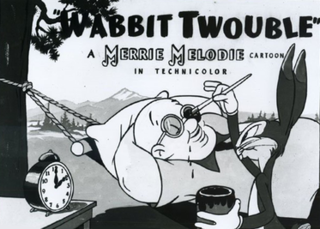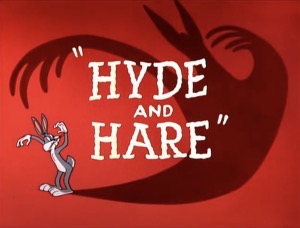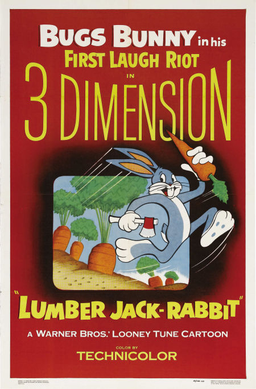
Bugs Bunny is a fictional character created in the late 1930s at Warner Bros. Cartoons and voiced originally by Mel Blanc. Bugs is best known for his featured roles in the Looney Tunes and Merrie Melodies series of animated short films, produced by Warner Bros. Earlier iterations of the character first appeared in Ben Hardaway's Porky's Hare Hunt (1938) and subsequent shorts before Bugs's definitive characterization debuted in Tex Avery's A Wild Hare (1940). Bob Givens, Chuck Jones, and Robert McKimson are credited for defining Bugs's design.

Looney Tunes is an American animated franchise produced and distributed by Warner Bros. It began as a series of short films that originally ran from 1930 to 1969, concurrently with its partner series Merrie Melodies, during the golden age of American animation. Following a revival in the late 1970s, new shorts were released as recently as 2014. The two series introduced a large cast of characters, including Bugs Bunny, Daffy Duck, and Porky Pig. The term Looney Tunes has since been expanded to also refer to the characters themselves.

Isadore "Friz" Freleng, credited as I. Freleng early in his career, was an American animator, cartoonist, director, producer, and composer known for his work at Warner Bros. Cartoons on the Looney Tunes and Merrie Melodies series of cartoons from the 1930s to the early 1960s. In total he created more than 300 cartoons.

Yosemite Sam is a cartoon character in the Looney Tunes and Merrie Melodies series of short films produced by Warner Bros. His name is taken from Yosemite National Park in California. He is an adversary of Bugs Bunny and his archenemy alongside Elmer Fudd. He is commonly depicted as a mean-spirited and extremely aggressive, gunslinging outlaw or cowboy with a hair-trigger temper and an intense hatred of rabbits, Bugs in particular. In cartoons with non-Western themes, he uses various aliases, including "Chilkoot Sam" and "Square-deal Sam" in 14 Carrot Rabbit, "Riff Raff Sam" in Sahara Hare, "Sam Schultz" in Big House Bunny, "Seagoin' Sam" in Buccaneer Bunny, "Shanghai Sam" in Mutiny on the Bunny, "Von Schamm the Hessian" in Bunker Hill Bunny, "Baron Sam von Schpamm" in Dumb Patrol, and many others. During the golden age of American animation, Yosemite Sam appeared as antagonist in 33 animated shorts made between 1945 and 1964.

Bugs and Thugs is a 1954 Warner Bros. Looney Tunes cartoon directed by Friz Freleng. The short was released on March 13, 1954, and stars Bugs Bunny, with Rocky and Mugsy. The film is a semi-remake of the 1946 cartoon Racketeer Rabbit. It is also the first Warner Bros short to feature Milt Franklyn as a musical director.

Cecil Turtle is a fictional character in the Warner Bros. Looney Tunes and Merrie Melodies series of films. Though he made only three theatrical appearances, Cecil has the unusual distinction in that he is one of the very few characters who were able to outsmart Bugs Bunny, and the only one to do so three times in a row and at the rabbit's own game. Cecil often gives Bugs the taunting nickname of "Speedy" when addressing the rabbit.

Rhapsody Rabbit is a 1946 American animated comedy short film in the Merrie Melodies series, directed by Friz Freleng and featuring Bugs Bunny. The movie was originally released to theaters by Warner Bros. Pictures on November 9, 1946. This short is a follow-up of sorts to Freleng's 1941 Academy Award-nominated Rhapsody in Rivets, which featured the "Hungarian Rhapsody No. 2" by Franz Liszt. The "instrument" used to perform the "Hungarian Rhapsody" in Rhapsody in Rivets is a skyscraper under construction, while this short features Bugs playing the piece at a piano while being pestered by a mouse.

Wabbit Twouble is a Merrie Melodies cartoon starring Bugs Bunny, produced by Leon Schlesinger Productions and released on December 20, 1941, by Warner Bros. Pictures.

Duck! Rabbit, Duck! is a 1953 Warner Bros. Merrie Melodies cartoon directed by Charles M. Jones. The cartoon was released on October 3, 1953 and stars Bugs Bunny, Daffy Duck and Elmer Fudd.

Hair-Raising Hare is a Warner Bros. Merrie Melodies cartoon, released on May 25, 1946. It was directed by Chuck Jones and written by Tedd Pierce. It stars Bugs Bunny and features the first appearance of Chuck Jones' orange monster character "Gossamer".

The Looney Looney Looney Bugs Bunny Movie is a 1981 American animated comedy package film with a compilation of classic Looney Tunes/Merrie Melodies Warner Bros. cartoon shorts and animated bridging sequences produced and directed by Friz Freleng, hosted by Bugs Bunny. The new footage was produced by Warner Bros. Animation. It was the first Looney Tunes/Merrie Melodies film with a compilation of classic cartoon comedy shorts produced by Warner Bros. Animation.

Baby Buggy Bunny is a 1954 Warner Bros. Merrie Melodies animated short directed by Chuck Jones and written by Michael Maltese. The cartoon was released on December 18, 1954, and stars Bugs Bunny. The story is about a short gangster named "Babyface" Finster who, after a clever bank robbery, loses his ill-gotten gains down Bugs' rabbit hole, forcing him to don the disguise of an orphan baby to get it back.

Acrobatty Bunny is a 1946 Warner Bros. Looney Tunes short directed by Robert McKimson. The short was released on June 29, 1946, and stars Bugs Bunny and Nero the Lion. This was the first cartoon McKimson directed that starred Bugs Bunny.

Hyde and Hare is a 1955 Warner Bros. Looney Tunes cartoon, directed by Friz Freleng. The short was released on August 27, 1955, and stars Bugs Bunny. The short is based on Robert Louis Stevenson's 1886 novella Strange Case of Dr Jekyll and Mr Hyde. The cartoon pits Bugs against Dr. Jekyll, who continues to turn into Mr. Hyde. The title is a play on the expression "neither hide nor hair."

The Abominable Snow Rabbit is a 1961 Warner Bros. Looney Tunes theatrical cartoon directed by Chuck Jones and co-directed by Maurice Noble, with a story by Tedd Pierce. The short was released on May 20, 1961, and stars Bugs Bunny and Daffy Duck.
A-Lad-In His Lamp is a 1948 Warner Bros. Looney Tunes cartoon. The short stars Bugs Bunny, and features the Genie and Caliph Hassan Pfeffer, who is after Bugs and the genie in his lamp. The voices of Bugs Bunny and Caliph Hassan Pfeffer are voiced by Mel Blanc, and the voice of the genie is played by Jim Backus. The cartoon is a takeoff of the story of Aladdin's Lamp. Elements of this short would later be re-used for the Arabian era in Bugs Bunny & Taz: Time Busters.

Lumber Jack-Rabbit is a 1953 3-D Warner Bros. Looney Tunes cartoon short directed by Chuck Jones and written by Michael Maltese The cartoon was released on September 26, 1953, and stars Bugs Bunny.

Rabbit's Feat is an animated 1960 Warner Bros. Looney Tunes cartoon, directed by Chuck Jones and written by Michael Maltese. The short was released on June 4, 1960, and stars Bugs Bunny and Wile E. Coyote. As Maltese had left for Hanna-Barbera, his name was removed from the credits.

Hugo the Abominable Snowman is a character in the Looney Tunes franchise.

















